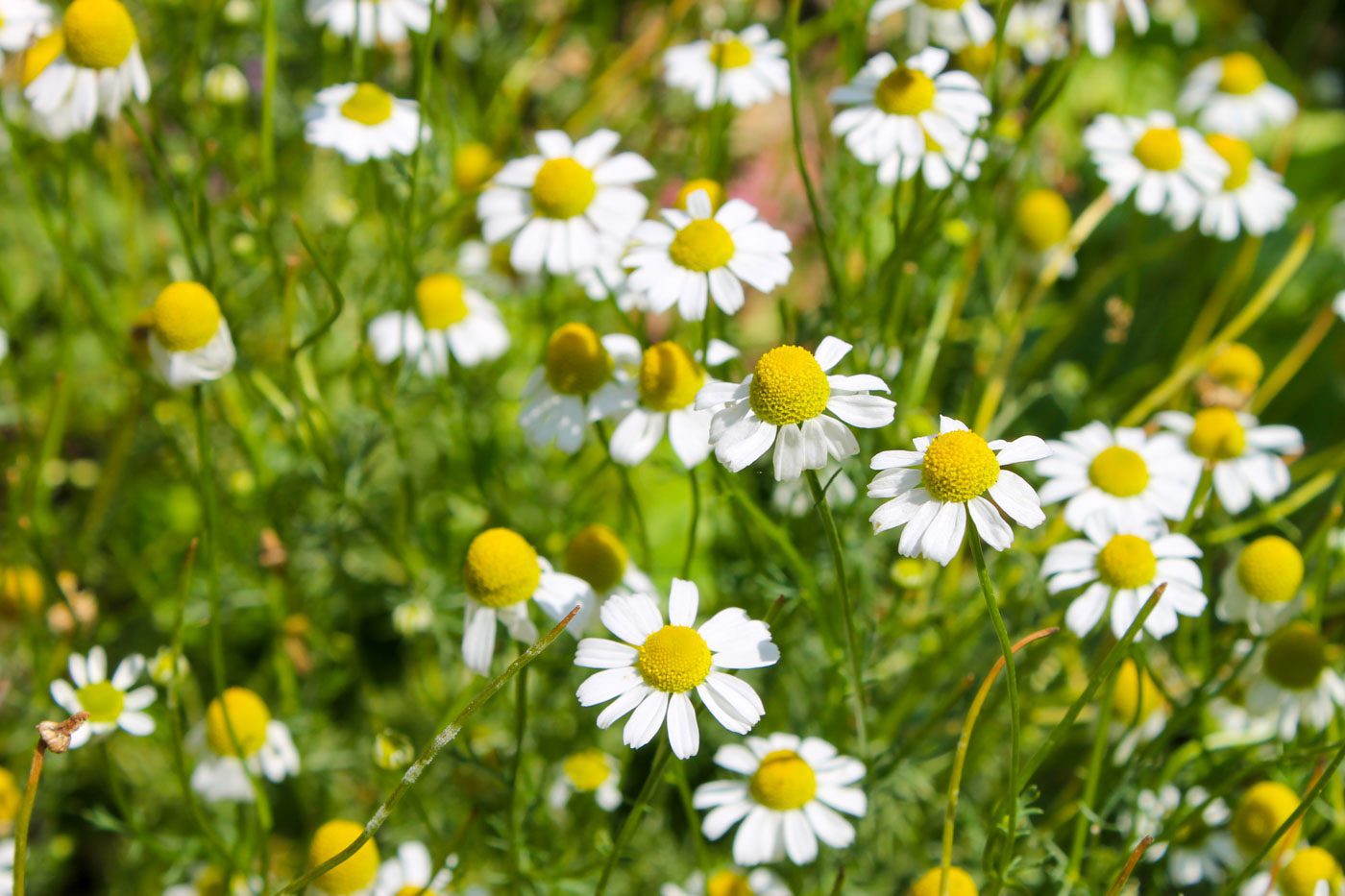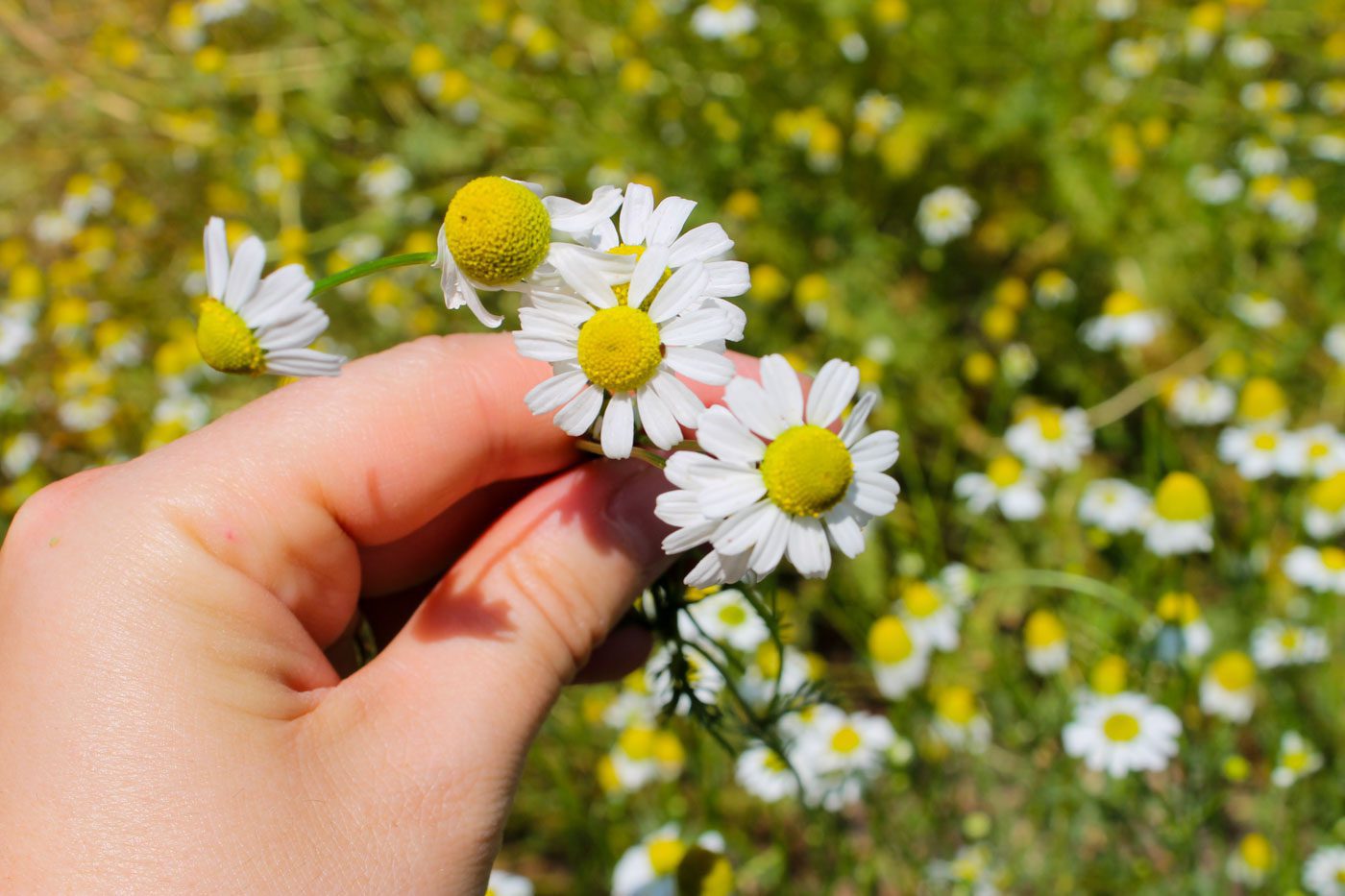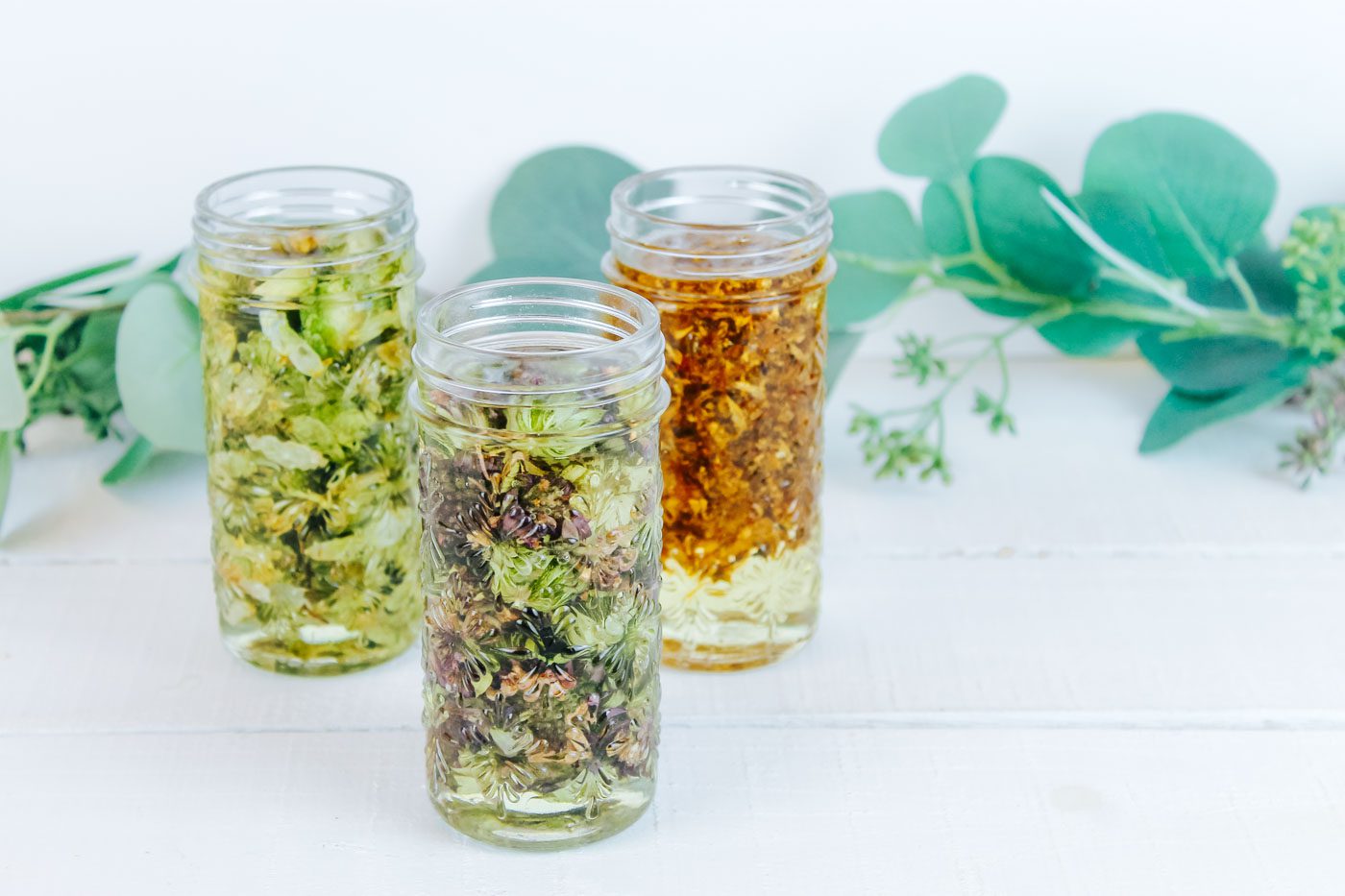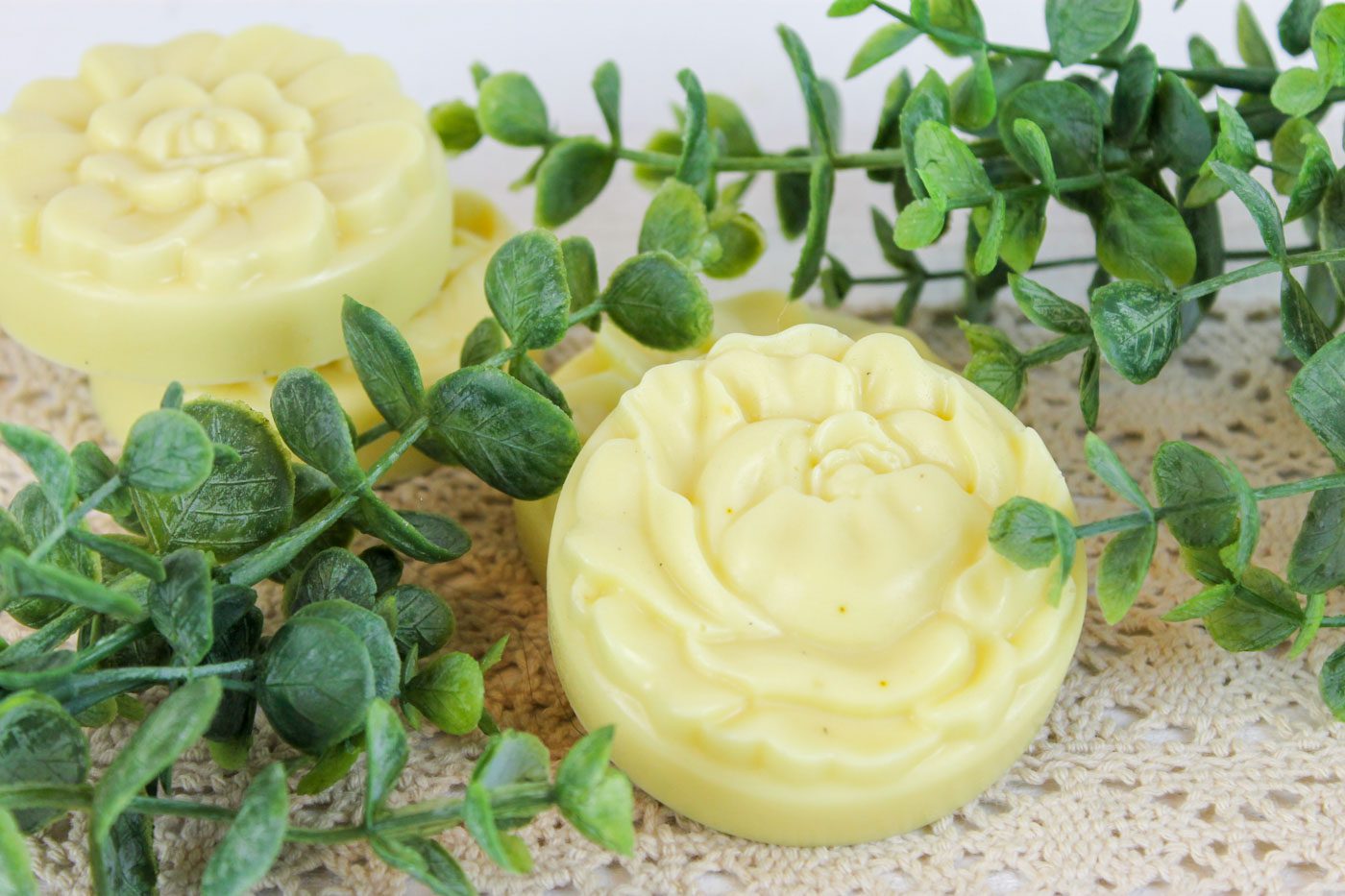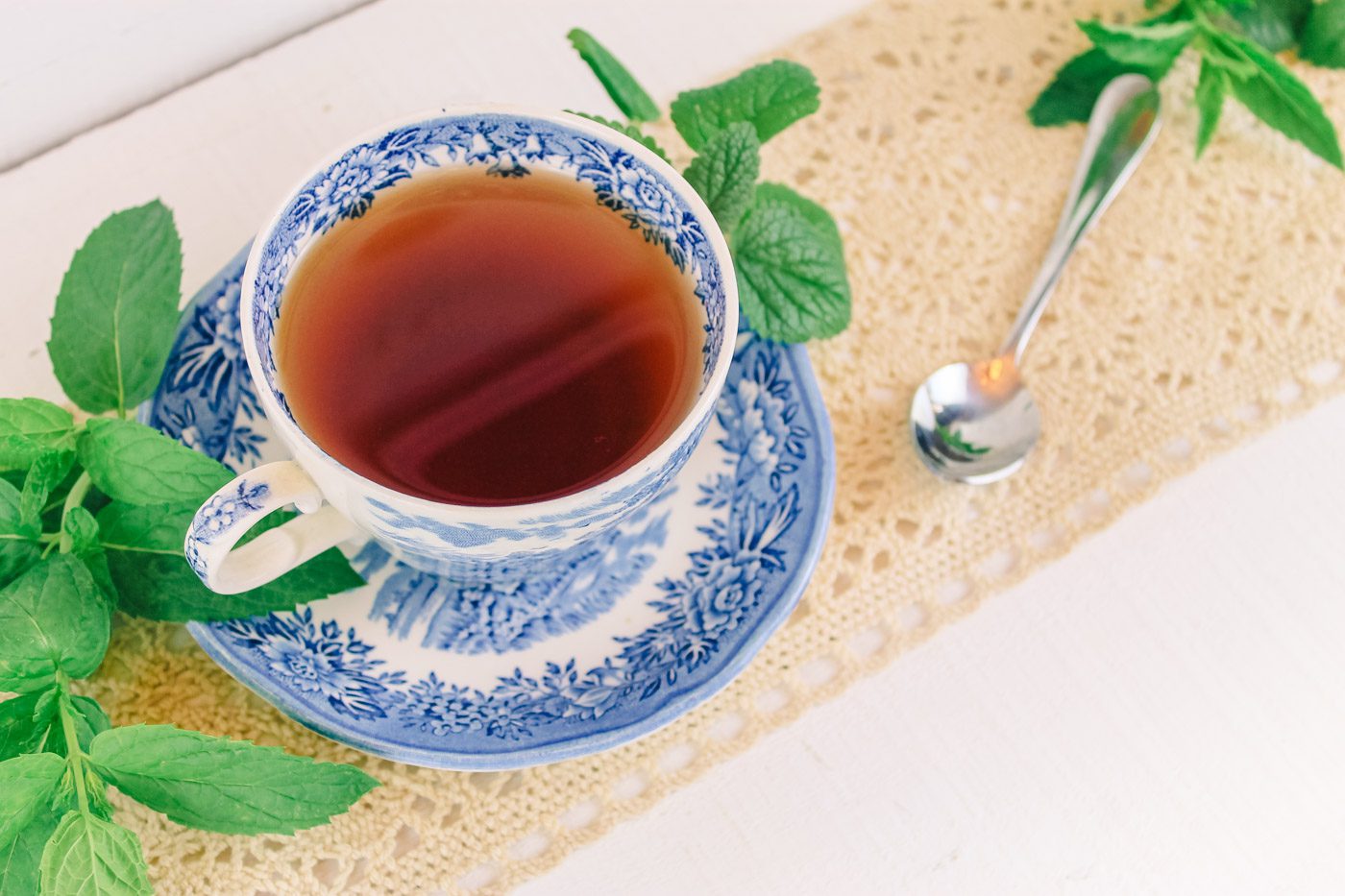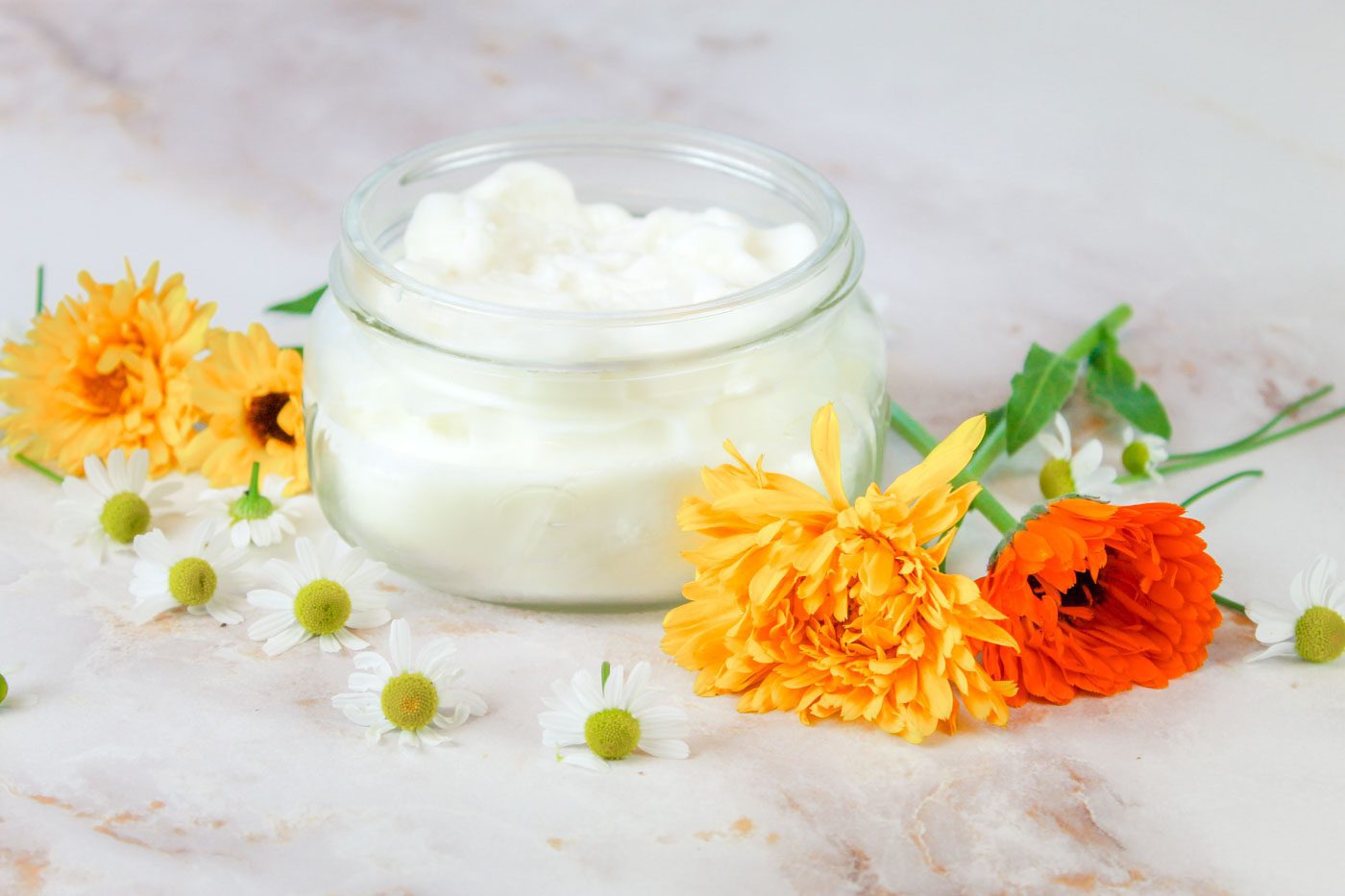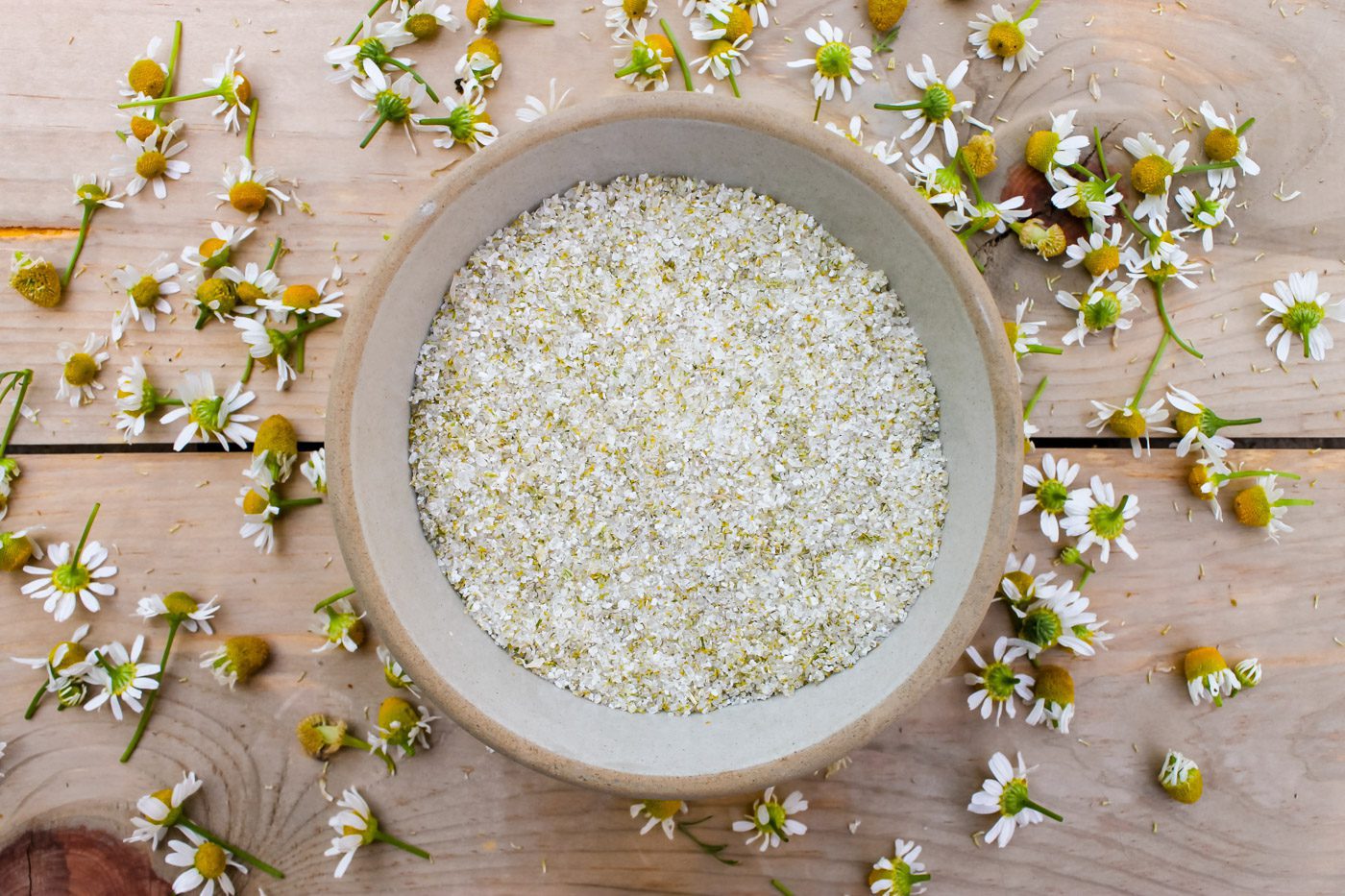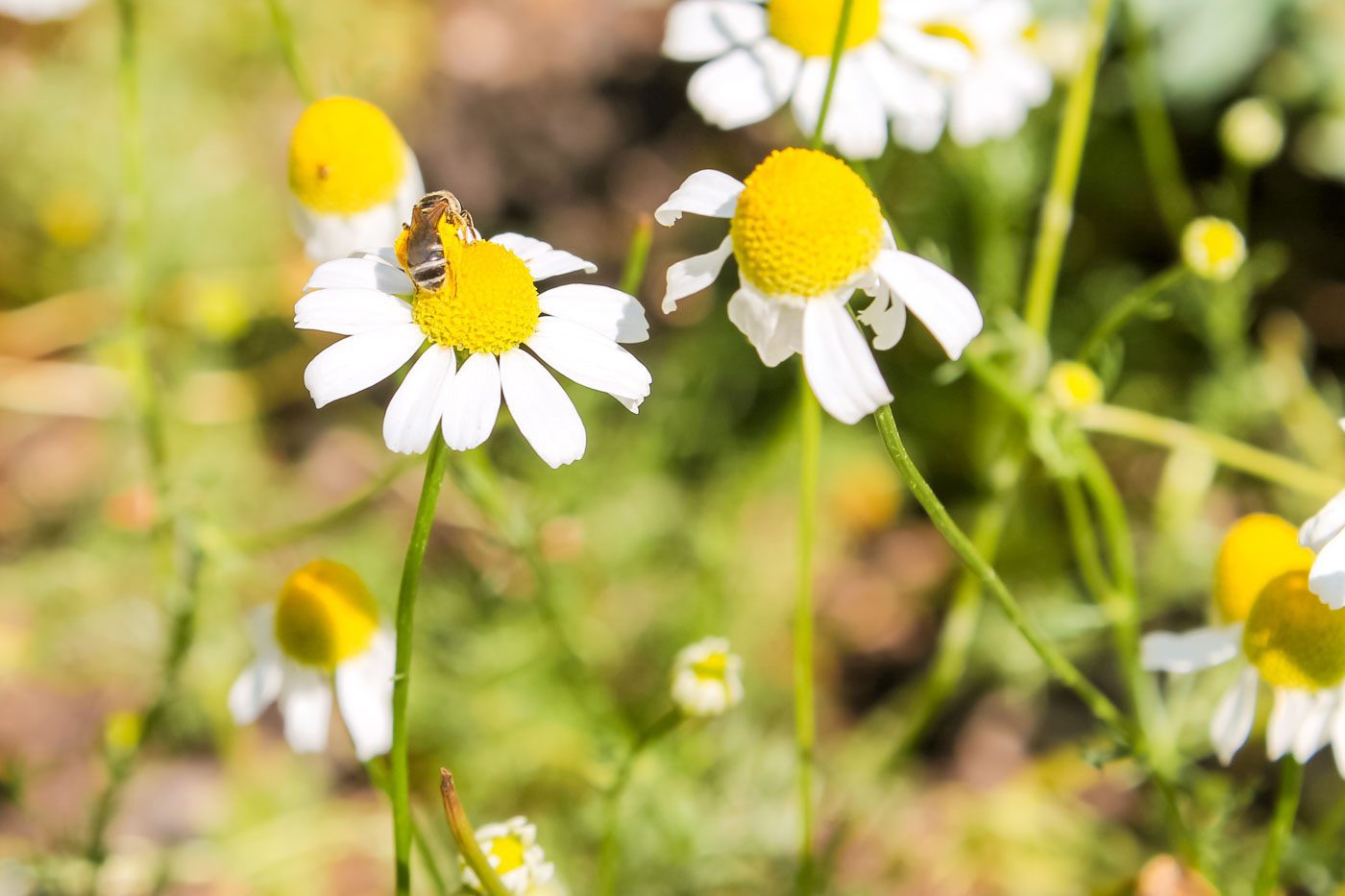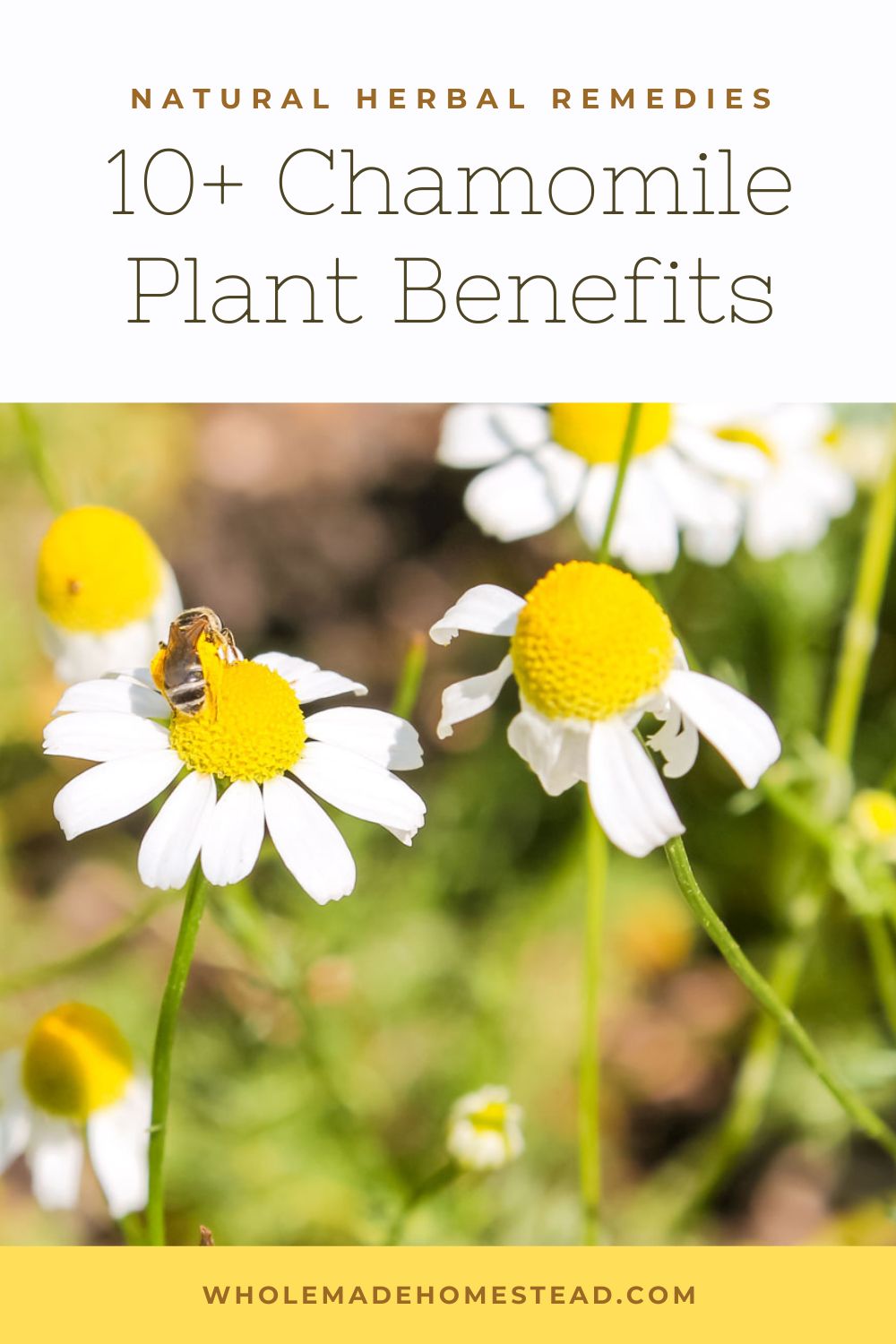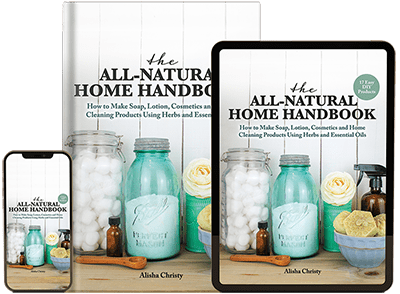Chamomile, a beautiful daisy-like flower, can be used to combat wounds, bruises and rashes, soothe an upset stomach, reduce anxiety, help you to get a good nights rest and can be added into homemade body care items like soap, salves, lip balm and bath salts. Discover over 10 ways to use chamomile as a natural remedy in your home.
Herbs are a terrific addition to any garden. While our backyard garden is dedicated to primarily vegetables (and this year a few watermelon plants), we always dedicate some space and a few containers to herbs. Many of the herbs we produce are used medicinally, for natural cold remedies, pain relief sprays, soaps and salves. We also grow a few herbal plants that are well known for their culinary purposes. Thyme is probably my favorite herb to use in cooking. It is particularly tasty on roasted chicken cooked in a cast iron skillet.
Amidst the medicinal herb family, we are quite fond of calendula, cayenne and echinacea. Chamomile was one of the first herbs ever grown in our small garden. Surprised by its size and adorable petite flowers, we grew to enjoy having chamomile in the garden each season. In our family we use chamomile in homemade body care items and as a powder to to calm the gut and nerves.
If you haven’t planted any chamomile in your garden, I highly recommended doing so. There are a vast array of uses for chamomile that you may find useful on your homestead. Below are our favorite ways to utilize the tiny, yet mighty chamomile flower.
What is Chamomile?
Chamomile (matricaria recutita) is a beautiful plant with tiny yellow and white flowers, similar in appearance to a daisy. There are two common varieties, including German chamomile and Roman chamomile. The little flower is the medicine and can be used to treat issues both internally and externally. For example, dried chamomile can be consumed to help soothe an upset stomach or intestinal tract and can help reduce anxiety. It is well know for its calming, slightly sedative properties to help people relax and get a good nights rest.
Externally, chamomile is great for soothing irritated skin, relieving rashes, redness and itchy skin. It has anti-inflammatory properties which makes it ideal to use in a bath salt. The anti-fungal attributes make this a wonderful soak for your toes and ankles.
How to Harvest Chamomile
As mentioned previously, the flower is the medicine. To harvest chamomile, carefully pop off the flower top, ideally in the early morning hours before the intense summer sun comes out. The petals on the flower head should be slightly slicked back when you go to harvest them. Alternatively, you can place your hand beneath the flowers and gently pull upwards, letting the stems run through your fingers and popping the heads off.
To preserve chamomile, lay the flower flat on a screen out of direct sunlight until completely dried. You can also use a freeze dryer or a dehydrator set on the lowest temperature to dry the chamomile. Once dried, store them in a jar with an airtight lid inside a cool, dark place. Use within one to two years. For complete details on how to properly dry homegrown chamomile, check out this blog post.
Things You Can Do With Chamomile
There are so many wonderful ways to use chamomile. Some of my favorite ways to use chamomile are in bath salts, as a rash relief spray and popping a few dried flowers into my mouth to help reduce anxiety when life gets stressful. Here are 10+ ideas to use chamomile flowers.
1. Chamomile Infused Oil
Infusing chamomile into oil is an excellent way to use this herb in topical applications such as lotion bars, salves and balms. There are plenty of oils to choose from but my go-tos tend to be sunflower oil and coconut. There are 3 ways to infuse chamomile into oil — the slow and steady method, the quick method and my favorite, the sunny window method.
To infuse chamomile into oil start by placing the dried flowers into a mason jar. Slowly pour your chosen oil over top of the herbs. If the herbs are not completely covered, push them below the oil with a spoon. The oil should cover the herbs by at least 1/4-inch.
Cap the glass jar with a lid and place inside a paper bag. Sit on the sill of a warm, sunny window. Shake the jar daily. Within 7-10 days, the infused oil will be ready to use. Strain the herbs and store in a cool, dark place for about 9 months.
You can learn the complete ins and outs of creating herbal infused oil by reading this article.
2. Make a Chamomile Tincture
Honestly, a year ago, I had no idea how powerful a tincture could be. Now that I know, we use them quite frequently on our homestead. So exactly what is a tincture?
Tinctures are a potent, portable form of herbal medicine. Often made with alcohol, such as vodka, a chamomile tincture is excellent for internal or external issues. Topically, it can treat things like bruises, wounds, rashes, diaper rash, eczema and inflamed skin. To create a chamomile tincture, fill a jar with dried chamomile flowers, then cover it with vodka. Cap the jar and store in a dark place for a few weeks. Shake the jar occasionally to make sure the herbs are still submerged below the vodka. Using a mesh strainer, strain the herbs out, pour the remaining liquid into a bottle. The chamomile tincture will last for many years.
3. Infuse into Homemade Chamomile Soap
Chamomile can be used in hot and cold processed soaps as well as melt and pour soap recipes. When it comes to the melt and pour method, chamomile flowers can be directly infused into the soap base, ground up into a powder and stirred into the melted soap or used as a decorative element to add to the tops of soap bars. Here are a few beginner soaps recipes that you could use chamomile in:
4. Chamomile Tea
If you’re looking for a tea to help tame tummy troubles, reduce menstrual cramps or give you peace of mind on those chaotic days, try a cup of chamomile tea. Chamomile tea has a bittersweet, apple-like flavor. It is great all on its own or can be paired with other herbs, a sweetener, milk or dried fruit.
What parts of chamomile do you use for tea? The flowers! To make chamomile tea, bring a cup of water to a boil. Add two teaspoons of dried chamomile into a cotton tea bag or tea ball. Place into a mug. Pour the hot water over the tea bag. Place a lid on your cup of tea and infuse for about 5 minutes. Covering your tea while it infuses is important so that the volatile oils in the herbs do not escape in the steam. Once the tea cools, sit back and relax to a nice cup of chamomile tea.
5. Help Reduce Anxiety
Widely known for its ability to calm, chamomile is often used as a nervine or mild sedative. To help the nervous system get back to a state of tranquility, chamomile can be ground into a powder using a spice grinder, tinctured or brewed into a warm cup of tea. Chamomile may be paired with other calming herbs such as lavender or skullcap to enhance its effects. Some people like to drink a cup of chamomile tea prior to bed time to help them relax and reduce insomnia.
6. Calm an Upset Stomach
Chamomile is noted to be terrific for gastrointestinal issues, such as gas, diarrhea, cramping and vomiting. It can be used as an antispasmodic, carminative, anti-inflammatory and a bitter tonic. While I personally prefer to use calendula over chamomile for an upset stomach, many have found it soothing to the digestive tract.
7. Add to Homemade Lotion
Chamomile infused oil can be used to create lotion bars and body butters. In this lotion recipe, I infused chamomile along with calendula and dandelion flowers into some coconut oil. The whipped body butter is a great overall moisturizer and can be used by most skin types.
8. Soothe Inflamed or Irritated Skin
Every summer I am bound to get bit by some bug or develop a rash from a plant. When chamomile is infused into oil, it helps to relieve the dreaded itch caused by flies, mosquitoes and other biting insects. Grab the recipe for all-natural bug bite relief here.
Recently I infused chamomile into witch hazel to create an all-purpose rash relief spray. The combination of chamomile, aloe vera gel and tamanu oil helps to reduce inflamed, irritated skin.
9. Create a Relaxing Bath Salt
Rest and relax while softening your skin with a chamomile bath salt. Thankfully bath salts are super easy to make and can be customized with your favorite herbs and essential oils. At the time of this post, chamomile is in full bloom. To make homemade bath salt, I simply clip the fresh flowers from the garden and mix them with a bit of epsom salt. If you don’t have access to any fresh chamomile, you can use dried chamomile. Add in a bit of orange essential oil, or your preferred fragrance and you’ve got a wonderful DIY bath salt to pamper yourself. You can grab my recipe for chamomile bath salt below.
10. Make Natural Body Care Products
With just a few ingredients, you can make a plethora of homemade body care items using chamomile. Salves and balms are a great way to treat you and your kids. Here are a few other ways use chamomile:
In: lip balm, lip gloss, bath bombs, facial mask, lotion bars, hair rinse and deodorant
11. Add to a Wax Sachet
While chamomile is must notably used to heal your body, it can also be utilized in DIY crafts such as a wax sachet. To make a natural air freshener, start by adding about a cup of soy wax into a heatproof glass bowl. Set the bowl on top of a saucepan with a few inches of water inside the pan. Turn the heat to medium. Melt wax. Remove bowl from heat and stir in your favorite essential oils. Pour wax into silicone mold. As the wax starts to cool and set up, it will become cloudy. Sprinkle dried chamomile flowers into wax. Once the sachet has cooled, you can now display your beautiful creation in your home while also freshening up your space.
FAQ
Which Chamomile is Medicinal?
Both types of chamomile, Roman chamomile and German chamomile are medicinal and have similar benefits. The primary differences between the two are their physical appearance and whether it returns the following spring or not. Roman chamomile is a perennial. German chamomile is an annual but it can often self-seed, making it appear like it is a perennial.
When to Plant Chamomile
I have found that it is best to sow chamomile seeds indoors approximately 45-60 days before the last frost date. Once the chance of frost has past (mid May for those living in the state of Ohio) chamomile can be transplanted directly into the soil within the garden. Learn how to start an herb garden by checking out this gardening tutorial.
What Does Chamomile Tea Taste Like?
A cup of chamomile tea has a fruity, apple-like taste, with an earthy, slightly bitter flavor. It pairs well with other mellow herbs, honey and a splash of milk. To enhance the apple flavor you can accompany the dried chamomile with dried apple chips and/or a few cinnamon chips.
More Natural Living Tutorials
How to Build a Raised Herb Bed
The information in the article is not intended to treat or prevent any disease. All information is for entertainment or educational purposes only. Please seek your physician for medical advice.

